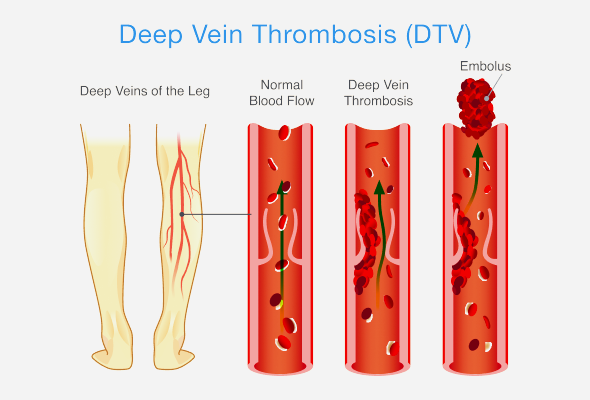Best Deep Vein Thrombosis (DVT) Treatment In Mumbai

Deep Vein Thrombosis: What Is It?
A clot, or cluster of blood cells, can form in your veins if blood flows too slowly. Deep vein thrombosis (DVT) is the medical term for when a blood clot forms in a vein located deep within your body. Your thigh, pelvis, or lower leg are the most likely places for this to occur. However, it can also happen in other body parts. DVT may cause serious health issues. It may be lethal in certain situations. That's why you need to see a doctor as soon as possible if you believe you have one. Book your appointment now with Dr. Kunal Arora provides Best Deep Vein Thrombosis (DVT) Treatment in Mumbai.
Typical signs of DVT include:
Deep vein thrombosis (DVT) surgery and procedures
Surgery and other procedures are typically explored as treatments for deep vein thrombosis (DVT) in specific circumstances where conservative measures like anticoagulant medication are ineffective or inappropriate. These treatments aim to dissolve or remove the clot, restore normal blood flow, and prevent consequences such as pulmonary embolism. Therefore get in touch with us because Dr. Kunal Arora provides Best Deep Vein Thrombosis (DVT) Treatment in Mumbai.
The afflicted vein's clot is physically removed during this surgical technique. Numerous methods, including open surgery and minimally invasive techniques like catheter-directed thrombolysis (CDT), can be employed. Clot-dissolving medicine is given during CDT via the use of a catheter to break up and restore blood flow to the clot location.
If DVT has caused significant damage to the vein or if vein constriction (stenosis) is likely, a venous stent may need to be placed. A stent is a small, inflatable tube composed of metal mesh that increases blood flow and helps maintain vein openings.
If a patient cannot take anticoagulant medication or if DVT persists following therapy, an IVC filter may be placed. This device is put into the inferior vena cava, a major vein that returns blood from the lower body to the heart, to capture and prevent blood clots from reaching the lungs. Contact us now because Dr. Kunal Arora provides Best Deep Vein Thrombosis (DVT) Treatment in Mumbai.
Complications of DVT
If DVT is not treated, it can lead to consequences such vein irritation, pulmonary embolism, and leg ulcers. The most serious type of DVT consequences is pulmonary embolism. It happens when the clot travels through the blood vessel system from the leg vein into the lungs. If the clot becomes stuck in the lungs, it may obstruct the major artery going to the lungs or one of its main branches.This causes oxygen and blood starvation in the lung tissue. It is estimated that about one-third of people who experience a major pulmonary embolism die. The life-saving treatment for pulmonary embolism is taking drugs that disintegrate the clot and restore blood flow. Contact us now for the Best Deep Vein Thrombosis (DVT) Treatment in Mumbai.
What Advantages Are There?
Blood clots in deep veins, usually in the legs, are referred to as deep vein thrombosis (DVT).
Reducing the chance of pulmonary embolism (PE), in which a clot escapes the vein and goes to the lungs, is the main advantage of treating DVT. PE can be fatal, thus stopping the spread of DVT is essential.
Leg pain, edema, and stiffness are among the symptoms that can be reduced with DVT treatment. This raises the patient's standard of living and increases their range of motion.
Post-thrombotic syndrome (PTS), a chronic consequence of deep vein thrombosis (DVT), is typified by edema, skin alterations, and limb discomfort. Getting the right care lowers the risk of acquiring PTS.
When DVT is treated effectively, especially with the right anticoagulant medication or other therapies, the risk of future clot formation and recurrence is reduced.
By restoring normal blood flow to the afflicted veins and lowering the risk of consequences including vein damage and venous insufficiency, treating DVT improves overall vascular health.
Conclusion
Improving patient outcomes overall and minimizing complications like pulmonary embolism depend on the proper treatment of deep vein thrombosis (DVT). Anticoagulant drugs are usually used in conjunction with lifestyle changes, venous stenting, and, in some situations, operative procedures such as thrombectomy to inhibit clot formation and lower the risk of clot dislodgement. Reducing the risk of repeated clots, preventing long-term consequences including post-thrombotic syndrome, and relieving symptoms like leg pain and edema are the main goals of successful DVT treatment. To guarantee the effectiveness and safety of therapy, routine monitoring and adherence to recommended therapies are crucial. Visit to our clinc now and consult with our Dr. Kunal who provides the Best Deep Vein Thrombosis (DVT) Treatment in Mumbai.
In order to track their status, patients are advised to attend routine follow-up consultations, adhere to suggested lifestyle modifications, and keep lines of communication open with their healthcare professionals.
